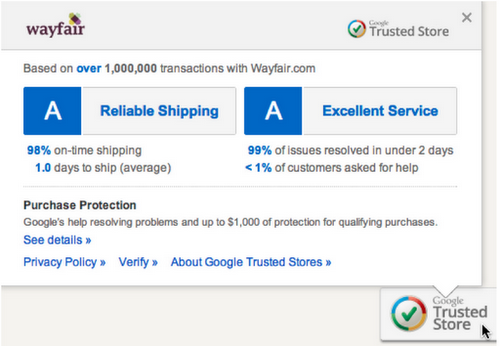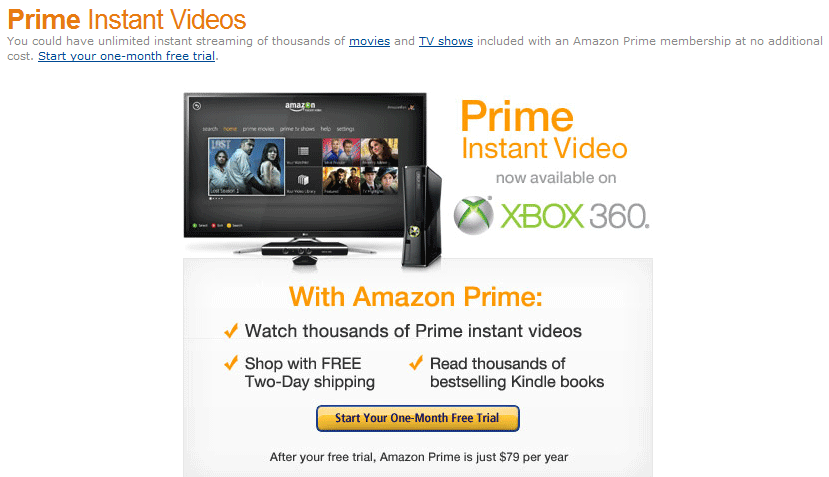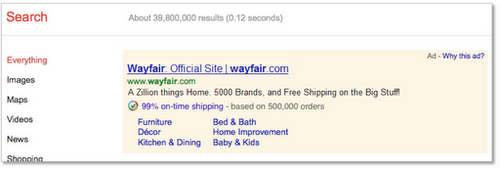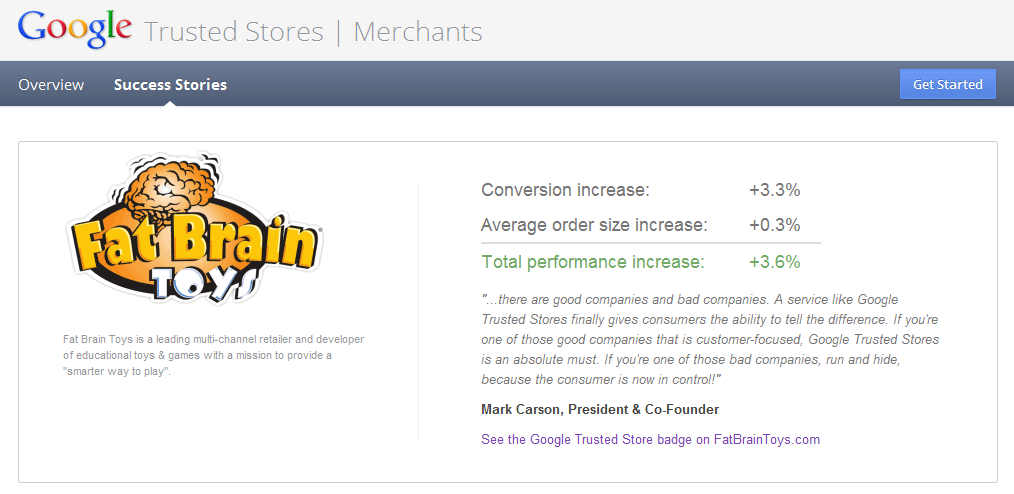Google Trusted Stores: A Potential Game Changer in eCommerce

Google Trusted Stores officially opened its application process to all U.S. merchants on June 7th, after a successful beta test with a small group that began in October 2011.
The goal is to offer shoppers a way to identify trustworthy merchants who provide an ideal shopping experience for consumers. It’s free to both merchants and shoppers, but merchants must meet a specified set of criteria to be eligible.
Merchants who meet shipping and customer service performance expectations, and who have successfully completed the application process, are able to display the Google Trusted Store Badge on their websites. Consumers can shop with confidence at these merchants knowing that they meet or exceed performance expectations.
![]() Google introduces Trusted Stores.
Google introduces Trusted Stores.
To qualify for the Google Trusted Stores program, merchants must meet certain performance criteria in both shipping and service. Here’s a breakdown:
This data is made readily available to shoppers, too. Consumers can mouse over the Google Trusted Stores Badge on your merchant site to expand it and view your statistics, including shipping reliability and customer service data, as well as the number of transactions the stats are based on.
 A sample Trusted Stores Badge and report card. (Image courtesy of Google)
A sample Trusted Stores Badge and report card. (Image courtesy of Google)
One caveat: Google isn’t providing any definitive metrics at this point. So we don’t know what the cutoff is for the percentage of complaints to orders that would disqualify a vendor.
So if your store doesn’t quite meet the performance criteria, and you’re thinking of spoofing a badge just to boost your shoppers’ confidence, you should know that Google has already built-in a verification system that will be pretty tough to fool. Shoppers can expand the badge and click, “Verify,” which sends them to a verification page on Google.com with the name of the merchant. So even if you manage to spoof a convincing badge, savvy shoppers will be able to tell it’s not authentic.
Google Trusted Stores shoppers can also voluntarily opt-in (at no charge) to receive up to $1,000 in purchase protection. Purchase protection covers the entire cost of a purchase, including tax and shipping. Basically, if a consumer shops at a Trusted Store and has an issue that they can’t resolve with the merchant, Google will step in and refund the purchase if the complaint is filed within 60 days of purchase.
Purchase protection applies to several situations:
However, purchase protection isn’t a product warranty. In other words, a product that arrives in expected condition but malfunctions within a few weeks does not qualify for purchase protection. And it applies only to product purchases; it doesn’t cover credit card or identity theft.
Critics may say Trusted Stores is merely an attempt to compete with Amazon Prime, but there are some significant differences between the two programs. Most importantly, Amazon Prime isn’t free to consumers. Shoppers pay $79 per year for unlimited two-day shipping, and members also receive unlimited access to instant-streaming videos through Amazon Instant Video.
 Amazon Prime members also receive access to Prime Instant Videos.
Amazon Prime members also receive access to Prime Instant Videos.
Amazon offers more specific data on cutoff points for seller metrics:
Amazon.com evaluates the performance of all its sellers by default, and while this information is available to shoppers on a limited basis, there’s no badge to differentiate top-scoring merchants from the rest of the pack. However, Amazon notifies poor-performers, typically requesting a measurable improvement within 60 days. Merchants can be suspended or banned for consistent poor performance. With Google Trusted Stores, merchants must apply to be considered as a Trusted Store.
The two programs have similarities, but are really based on different models. Amazon Prime is primarily focused on offering speedy shipping, whereas Trusted Stores is more a mechanism to differentiate high-quality merchants from those offering mediocre service or with frequent shipping delays. What’s confusing is that Google has announced plans for a shipping network that would be more direct competitor to the Amazon Prime program around the same time as it launched its beta test of Google Trusted Stores.
SearchEngineWatch predicts a shipping network could be problematic for Google, although if it’s a success it would give a much-needed boost to both Google Wallet and Google Checkout. It would also compliment Google Offers and could position Google as a viable competitor to Groupon and similar deal-sourcing websites.
But Google likely sees this move as a necessary effort to protect its standing in its core service area: Search. That’s because Amazon.com is nudging Google out in terms of product search, thanks in part to the success of Amazon Prime. The Wall Street Journal cites research by comScore which shows that Amazon handled three to four times as many product searches as Google Shopping over the past year.
The ability to put a Trusted Stores badge on a merchant website is a great benefit for qualified retailers, but what about an endorsement in a paid search ad? Google is testing a few different versions of endorsements to see which ones are the best-performing, according to SearchEngineWatch.
One version lists “Google Trusted Store” below the link to the retailer, another features the badge and shows performance data. As of April 2012, there were only about a dozen Trusted Stores retailers taking part in this test, and there’s been no official announcement from Google on when endorsements would be available to merchants for use in paid search ads.
 The Google AdWords badge will be rolled out to participating merchants soon. (Image courtesty of Google.)
The Google AdWords badge will be rolled out to participating merchants soon. (Image courtesty of Google.)
Merchants are already talking about Trusted Stores and the potential effects the program could have on SERPs. There’s also been a bit of strife regarding the qualifications for the program; one merchant complains that he went through the entire signup process only to find out that merchants must have a minimum of 1,000 transactions to be eligible to display the Trusted Stores Badge.This requirement isn’t clearly outlined in any of Google’s information, so unless they make it known soon, they may have a few disgruntled vendors who wasted time trying to sign up.
Google is already sharing a few success stories of merchants using the program who have experienced increased conversion rates and increases in average order size. A few examples:
 Fat Brain Toys is one merchant already experiencing growth thanks to participation in Google Trusted Stores.
Fat Brain Toys is one merchant already experiencing growth thanks to participation in Google Trusted Stores.
Consumers will be more likely to buy from merchants displaying the Trusted Stores Badge. If you had the advantage of choosing between two vendors, one with proven customer satisfaction scores and one with no evidence of performance, which would you choose?
